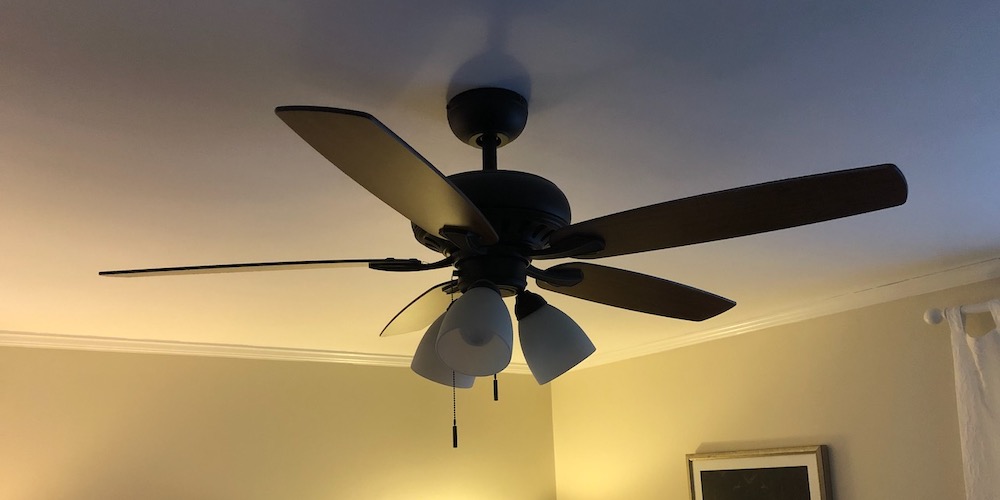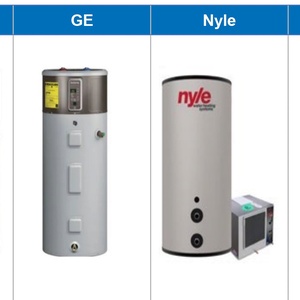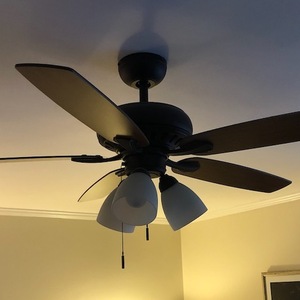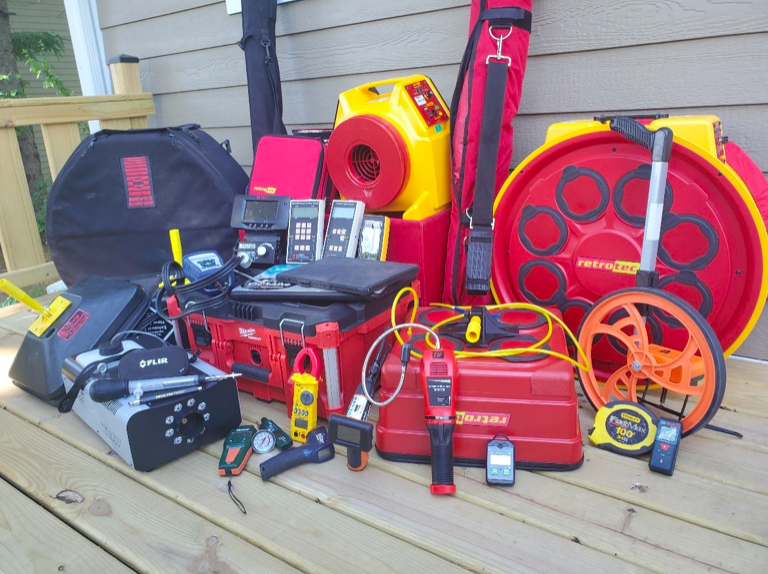
When you turn on your toaster, you know what happens to the electricity going through those filaments. You can feel it. The energy you extract from the electricity turns directly into heat. But what about the other electrical devices and appliances in your home? What happens to the energy the utility company charges you for?
An energy conversion example
Let’s look at an example of something I’ve written about several times: ceiling fans. Ignoring the lights sometimes installed, we know the electricity’s main purpose is to turn the blades of the fan. The motion of the fan blades then moves the air in the room. The idea is to move air across the skin to aid comfort and evaporative cooling.

But that’s not the end of the story. First, ceiling fans convert electricity to motion using an electric motor. We don’t have superconductors in these motors, so they’re not 100% efficient. Touch any motor that’s been running for a while, and you’ll notice that it’s warm. Some of the electrical energy gets converted to heat right there in the motor. The rest goes to moving the fan blades.
But what happens to the kinetic energy of the fan blades and air molecules? It, too, eventually becomes heat. The large-scale motion of the air in the room gradually becomes small-scale motion of the molecules. And the small-scale motion of the molecules, their kinetic energy, is what temperature is a measure of.
How much heat does a ceiling fan add?
Ceiling fan power use isn’t very high, though, so it doesn’t add a lot of heat to a room. If you run it on low or medium, where it’s more efficient, you may use 30 watts (W). How much heat would that add to a room if you left it running all day?
30 W x 24 hr = 720 Wh = 0.72 kWh
0.72 kWh x 3,412 BTU/kWh = 2,457 BTU
In terms of the hourly cooling load that adds to the room, we just divide the result above by 24 hours to find that it adds about 100 BTU/hr. In a small, energy-efficient house, the cooling load in a bedroom might be only 500 BTU/hr. The ceiling fan in this case would increase it by about 20 percent. In a large, less efficient house, the bedroom cooling load might be 2000 to 3000 BTU/hr. Keeping the ceiling fan run running there would make little difference.
A law of nature
The same principle is true for all the electricity you use inside the home. The electricity you use gets converted to heat almost entirely. Why do you think computers have cooling fans? Why do server rooms need air conditioning? When we do cooling load calculations for our clients, we include appliance loads because the electricity that goes into the refrigerator, for example, turns into heat in the kitchen.
We can go appliance-by-appliance and device-by-device through the house and examine what happens to the electricity in each. Some of the electrical energy gets converted to heat immediately. The rest gets converted to whatever form of energy is needed for the purpose of the device or appliance. It’s mostly motion, light, or sound for the things that aren’t meant just for providing heat.
Eventually, as with the ceiling fan example, those intermediate forms of energy used in your home become heat, too. We know it has to go somewhere because of the law of conservation of energy. Heat is often the last step in the energy conversion process. Why? Because it’s difficult to convert low-temperature thermal energy to more useful types of energy. (See my article on rejected energy.)
Some scientists speculate that one possible end for the universe is what they call heat death, when everything exists at the same temperature. There will be no light or electricity or chemical reactions, just matter at a fairly uniform temperature throughout the universe.
The connection between your electric bill and heat added
Most of the heat from indoor electricity use stays in your house. The only indoor electrical energy consumption that doesn’t add heat to your house would be the little bit of light, sound, or moving air that leaves the home.
That’s probably not much either. The amount of energy it takes to make light, for example, is pretty low. A 100-watt incandescent bulb turns electrical energy into 90+ watts of heat and less than 10 watts of light. The amount of energy you lose to the outdoors through light, sound, or motion is probably a small fraction of the total electricity you use indoors.
Let’s say your electric bill showed that you used 1000 kWh in a month. If all of that energy was used indoors, you would have added about about 3.4 million BTUs of heat to your home during that month. That would be about 4700 BTU/hr, or about 40% of a ton of cooling load.
Be careful, though. That 1000 kWh electricity use may not all be indoors. In winter, if you heat with a gas furnace and don’t use much electricity outdoors, you’re going to get close to 1000 kWh of heat (3.4 million BTU). But if you heat with a heat pump in winter or use an air conditioner in summer, some of your electricity-to-heat conversion occurs outdoors.
I’ll let Henry Gifford have the last word here. In his wonderful book Buildings Don’t Lie, he wrote, “Heat is the ultimate form of energy because all energy is either heat now or on its way to being transformed into heat.”
Hat tip to John Semmelhack for straightening me out on this issue about a decade ago.
________________________________________________________________________
Allison A. Bailes III, PhD is a speaker, writer, building science consultant, and the founder of Energy Vanguard in Decatur, Georgia. He has a doctorate in physics and is the author of a popular book on building science. He also writes the Energy Vanguard Blog. You can follow him on Twitter at @EnergyVanguard.
Weekly Newsletter
Get building science and energy efficiency advice, plus special offers, in your inbox.















20 Comments
"Used electricity" is a wonderful term. But is it not disguising that it is "wasted electricity?" Should we not just call it what it is? That motor on the fan could be more efficient. The blades could be better designed. There's no Carnot efficiency governing this.
Lloyd,
I wouldn't call it wasted under the right circumstances. Maybe partially underutilized? In the winter all that energy would typically go into heating the house, which you would have had to use electricity for in the first place.
LLoyd: I think you missed my main point, which is: No matter how efficient the device is, the electrical energy will eventually become heat. If you have a 100% efficient fan, it converts 100% of the electrical energy to kinetic energy of air. That kinetic energy, though, turns into thermal energy over time.
I didn't think I missed your point, but you are right, under the second law, it all degrades to less useful energy, more entropy. Forgot my physics.
I'll throw in the term "repurposed electricity", as it's currently heating season. :-)
Heating Degree Days are based on 65F. Is this still valid with LED lights and hopefully more efficient appliances, fans and the like?
user-723121: A better question is, was it ever valid? The idea behind using 65 °F as the base temperature for heating degree days is that that's the temperature at which you'll need to turn the heat on as the temperature drops. Early data from the Nest thermostat showed that 59 °F was the average for millions of homes with Nests. The better the building enclosure, the lower the actual base temperature is.
Do PHPP or other passive house type software modeling systems take this into account much on the heating end as well? On even a Pretty Good House, the idle appliance load might be somewhat significant. I'm thinking back to your article where your undersized heat pump was sufficient in the cold snap. Maybe latent appliance loads help fill the gap.
Internal heat gains are integral to the PHPP software, and I'm pretty sure BEopt, the free program that a lot of Pretty Good designers use, includes an estimate of internal heat gains as well. Since there are few hard-and-fast rules for designing a PGH, you can choose whether to include internal gains or even to do an energy model at all.
How about when I charge all my Milwaukee red-lithium battery packs and then go do work someplace else!
Or when I heat up a pizza and take it outside to eat.
But in seriousness, I suspect that as heat pumps and EV's become more common, a higher percentage of the electric bill will NOT go towards interior heating.*
Oh another one: Hot water going down the drain (if electric water heater), or even the KE of the water itself if you have an inside pump.
*well, I guess heat pumps in heating mode would, and then some :()
maine_tyler: Yes, hot water definitely will carry some used electricity down the drain and out of the house if the water heater is electric. I missed that one. Thanks.
Great explainer. As a mechanical engineer I think about this a lot. Often tell my wife it doesn't really matter if we leave the lights on in the winter, it's just replacing some of our heating load (which is resistance heating for now, working on upgrading that).
Probably worth noting one significant "indoor" electrical use that isn't really indoors. The electrical energy added to hot water mostly goes down the drain, of course (absent recovery).
During the summer, in many climates, a huge "outdoor" load is the swimming pool pump. This load usually occurs at a time of the year when homeowners don't need heat.
Actually, in many parts of the country, the "huge 'outdoor' load" is not the swimming pool pump, but swimming pool heating using gas or electric heating. This is presently very much something that I'm personally involved with as a Planning Board member in Chilmark, MA. We are engaged in trying to require solar or heat-pump pool heating and motorized covers for anyone that wants to heat a pool. We're having difficulty in writing bylaw changes that will pass muster with the state Attorney General, as municipalities are not presently allowed to have bylaws stricter than the state, which is based on the International Pool Code.
There have been a couple of interesting facts that I've learned during this effort. First heated pools use a surprising amount of energy. A 1,000 sqft pool requires about 14,000kwh of energy to heat from May 1 to Sept 30 with a heat-pump heater if uncovered. This is reduced to about 2,600kwr using a motorized cover when the pool is not in use. These figures increase by a multiple of about 5 using resistance electric heat instead of a heat-pump.
The pool code requires a cover unless 70% of the energy to heat a pool comes from "site-recovered energy." Interesting term....what does that mean? It could be solar pool heating, or more usually, using a heat recovery system where the pool is heated by passing pool water through a heat exchanger using A/C exhaust air from the house. THat's a pretty cool way of recovering energy from the A/C....but it's works somewhat counter to the demand for pool heating in that the cooler the climate, the more pool heating is needed and less A/C.
Not to get too far off topic... But it is interesting that there is so little out there on retaining heat in a pool. A LOT of heat is lost to evaporation, which is where your cover comes into play. But insulating a pool seems beneficial too, just never really done. Some of my colleagues have pools, they have said their gas bill is a decent bit more in the summer vs winter here in Michigan.
When I was a kid my family built our own pool using aluminum-skinned, EPS-core SIPs. The pool was round, like an above-ground, but the walls were structural enough to retain 3'+ of soil. I'm sure it reduced heat loss a bit but being in Maine, we drained the pool in cold weather.
I assume the point of dealing with pool energy use is to reduce total energy use and a pool might be considered low hanging fruit. Does Chilmark regulate building size too? I'd think those big houses all over up island towns must use a lot of energy too.
yes. they do regulate size.... minimum lot size is 3 acres. Total square footage allowed on 3 acres site is 3,5o0 sgft with additional sq ft for larger lots. Total square feet is for main dwelling plus any subsidiary dwelling such as a guest house, detached garage, etc.
gary__b: Yep, I missed the used electricity leaving with hot water from electric water heaters. Thanks.
Hi hughw: when I replaced my (in ground) pool liner in Southampton NY, we were able to put rigid foamboard insulation 2 inch R10 under the new liner. The pool became significantly warmer, much less temperature stratification, and a much quicker warmup via the solar heater. (Unfortunately we could not insulate the other 4 sides surfaces without rebuilding the pool). My pool otherwise had been exchanging heat with the 52F ground 24/7 on the bottom side. I wonder if a change in pool building code to require 2 inch or perhaps 3 inch rigid insulation on all 5 sides might be exceptionally cost effective as well as much more comfortable and energy efficient? Jan
P.S. some pool supply vendors offer a colorless non toxic liquid which floats on the top water surface and ostensibly does not evaporate, which might take the place of a pool cover at least during the summer months? I have not yet tried it, as my pool already stays warm all summer with zero fossil fuel usage (its variable speed pump runs off of the solar PV panels).
Log in or create an account to post a comment.
Sign up Log in